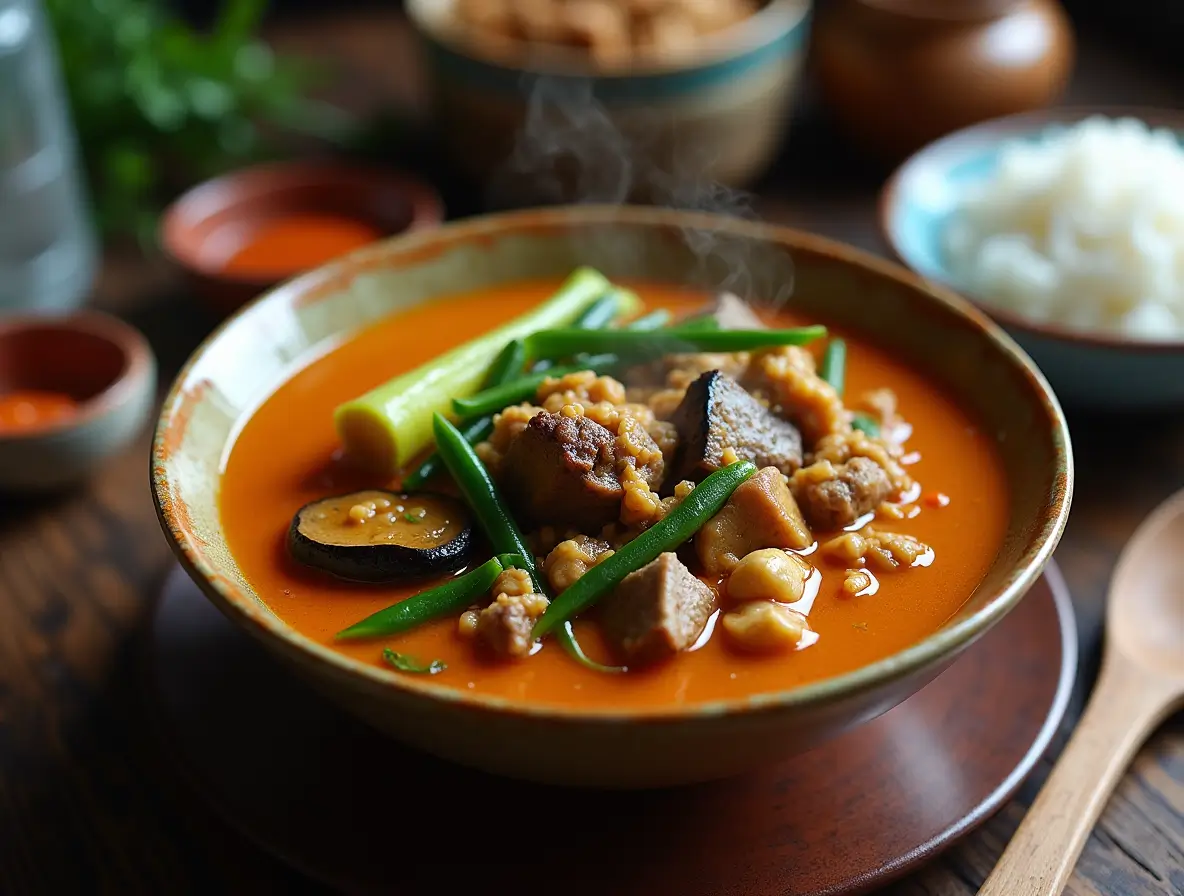A Delicious Filipino Stew with Peanut Sauce
Table of Contents
The rich, nutty aroma of Kare-Kare simmering on the stove instantly transports you to a Filipino family gathering, where this iconic peanut-based stew takes center stage. This hearty, flavorful dish combines tender oxtail, tripe, or beef chunks with crisp vegetables, all bathed in a velvety peanut sauce that’s simultaneously comforting and exotic. What makes Kare-Kare truly special is its perfect balance of textures and flavors – from the fall-off-the-bone meat to the vibrant vegetables and the silky, savory-sweet sauce that ties everything together.
Did you know that Kare-Kare’s origins date back to the Spanish colonial period in the Philippines? Some food historians believe the dish was influenced by Indian curry, which explains its name, while others argue it’s a purely Filipino creation evolved from pre-colonial cooking techniques.
Despite its impressive presentation and complex flavors, Kare-Kare is surprisingly approachable for home cooks. While traditional preparation can be time-consuming, my streamlined version maintains all the authentic flavors while cutting down on cooking time, making it perfect for a special weekend family meal.
If you’ve enjoyed my Chicken Adobo recipe (another Filipino favorite!), you’ll absolutely love this Kare-Kare. Both dishes showcase the beautiful blend of native Filipino cooking with influences from Spanish, Chinese, and Malay cuisines that makes Filipino food so unique. So gather your ingredients, roll up your sleeves, and get ready to create a pot of pure Filipino comfort food that will have your family asking for seconds!
What is Kare-Kare?
Ever wondered what happens when beef, peanut butter, and Filipino cooking expertise collide? You get Kare-Kare, a magnificent stew that’s been winning hearts (and stomachs) across generations! This rich, nutty delight gets its quirky name from “curry” (kare in Filipino) and “kare” (meaning stew), though it tastes nothing like Indian curry. Isn’t language funny sometimes? My Filipino grandmother always said Kare-Kare was invented by a resourceful cook who had nothing but oxtail, peanuts, and vegetables in the pantry – talk about making culinary magic from simple ingredients! As the old saying goes, “the way to a man’s heart is through his stomach,” and this dish has certainly been responsible for many happy marriages in the Philippines! Why not bring some Filipino flavor to your kitchen tonight? Your taste buds will thank you!
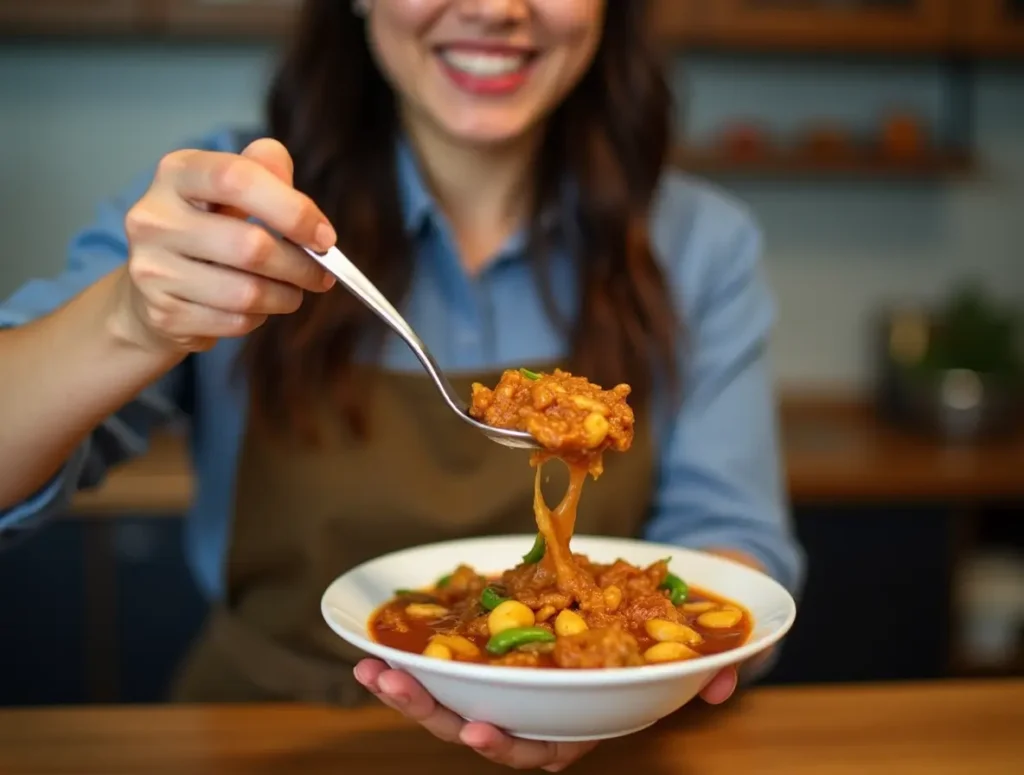
Why You’ll Love This Kare-Kare:
This Kare-Kare recipe is guaranteed to become a family favorite for so many reasons! First and foremost, the star of the show is the incredibly smooth, rich peanut sauce that coats every morsel with its nutty goodness. The sauce achieves a perfect balance – luxuriously thick yet still light enough to let the other flavors shine through. The depth of flavor is truly unmatched in other stews!
Making Kare-Kare at home is also surprisingly economical. While Filipino restaurants might charge $15-20 for a single serving, this recipe feeds 6-8 people for roughly the same cost. It’s also a fantastic way to use more affordable cuts of meat like oxtail or beef shank, which become meltingly tender through the slow cooking process.
What really elevates this dish is the traditional pairing with bagoong (fermented shrimp paste), which cuts through the richness of the peanut sauce with its salty, umami punch. The contrast between the creamy stew and the sharp condiment creates a flavor experience that’s truly mind-blowing. If you enjoyed my Pancit Bihon recipe last month, you’ll appreciate how Kare-Kare similarly showcases the beautiful complexity of Filipino cuisine. Ready to transport your taste buds to Manila? Let’s start cooking!
How to Make Kare-Kare:
Quick Overview
This Kare-Kare recipe transforms humble ingredients into a showstopping dish that tastes like it’s been simmering for days. The secret lies in the careful preparation of the meat, which becomes fall-apart tender, and the luscious peanut sauce that develops incredible depth of flavor. While traditional recipes can take hours, my streamlined version delivers authentic results in just about 2.5 hours (with much of that being hands-off simmering time). The result is a comforting, hearty stew that’s perfect for weekend family dinners or special occasions.
Key Ingredients for Kare-Kare:
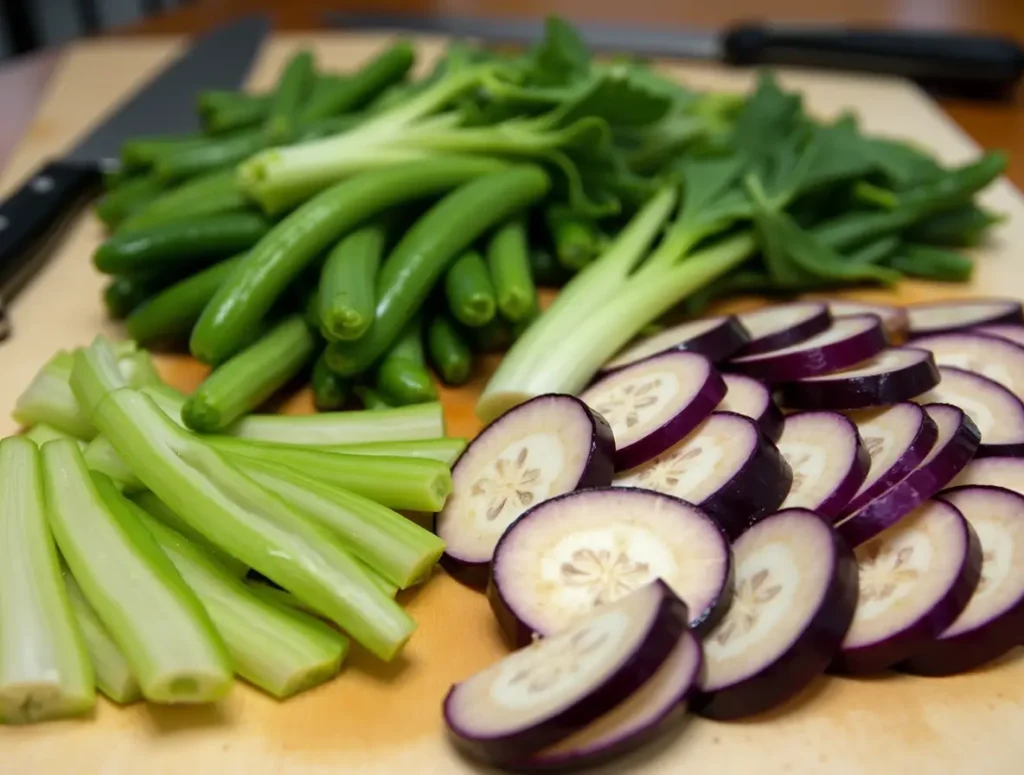
- 2 lbs oxtail (or beef shank/beef chuck), cut into 2-inch pieces
- 1 lb tripe (optional, cleaned and pre-boiled)
- 1 large onion, diced
- 6 cloves garlic, minced
- 3 tablespoons annatto powder (or annatto oil)
- 1/2 cup creamy peanut butter
- 1/4 cup ground toasted rice (uncooked rice, toasted and ground)
- 4 cups beef broth
- 2 tablespoons fish sauce
- 1 tablespoon brown sugar
- 1 bundle bok choy or pechay, cut into large pieces
- 2 eggplants, sliced diagonally
- 1 bundle string beans, cut into 2-inch pieces
- 2 banana flowers (or hearts), sliced (optional)
- 2 tablespoons cooking oil
- Salt and pepper to taste
- Bagoong alamang (fermented shrimp paste) for serving
Step-by-Step Instructions:
- Prepare the meat: In a large pot, add the oxtail pieces and cover with water. Bring to a boil and simmer for 10 minutes. Drain and rinse the meat to remove impurities. This step ensures a cleaner-tasting broth.
- Cook the meat until tender: Return the cleaned oxtail to the pot and add fresh water to cover by 1 inch. Add 1 teaspoon salt and bring to a boil. Reduce heat to low, cover, and simmer for 1.5-2 hours, or until the meat is very tender. If using beef chuck, cooking time may be reduced to 1-1.5 hours. If adding tripe, add it during the last 30 minutes of cooking.
- Prepare the peanut sauce: While the meat is cooking, heat oil in a separate large pot over medium heat. Sauté onions until translucent, about 3-4 minutes. Add garlic and cook for another minute until fragrant. Add the annatto powder and stir quickly to color the oil and prevent burning.
- Develop the sauce: Add peanut butter to the pot and stir continuously for 2-3 minutes until it starts to caramelize slightly. Pour in 1 cup of the beef broth (from cooking the meat) and stir until smooth. Add the ground toasted rice and mix well to avoid lumps.
- Combine meat and sauce: Once the meat is tender, transfer it to the peanut sauce mixture. Add 3 more cups of the beef broth, fish sauce, and brown sugar. Stir gently and simmer for 15 minutes, allowing the flavors to meld.
- Cook the vegetables: Add the vegetables in stages based on cooking time: string beans first (5 minutes), followed by eggplant (3 minutes), and finally bok choy (just 1 minute). This prevents overcooking and ensures each vegetable maintains its texture.
- Check consistency and seasoning: The sauce should be thick enough to coat the back of a spoon but still pourable. If too thick, add more broth; if too thin, simmer longer. Adjust salt and pepper to taste.
- Serve: Transfer to a large serving bowl and serve hot with rice and bagoong alamang on the side.
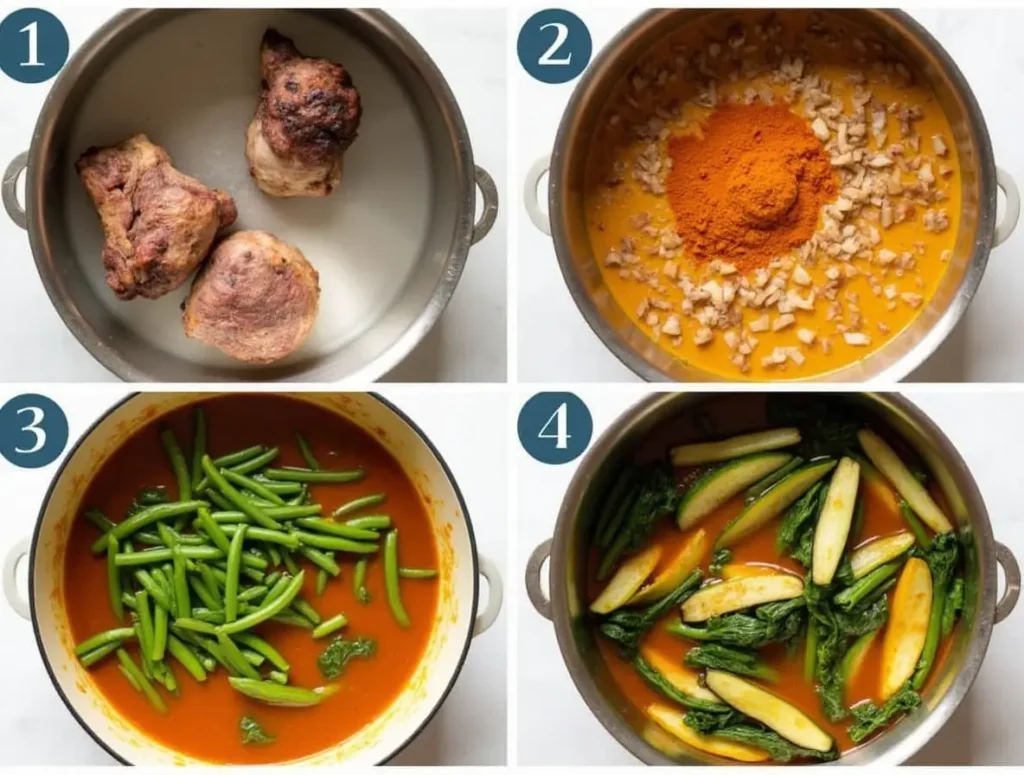
What to Serve Kare-Kare With:
Kare-Kare is traditionally served with several accompaniments that enhance its rich flavors:
- Steamed White Rice: An absolute must! The neutral rice provides the perfect canvas for the rich stew and helps balance the intensity of the peanut sauce.
- Bagoong Alamang: This fermented shrimp paste is the traditional condiment for Kare-Kare and provides a salty, umami punch that contrasts beautifully with the creamy peanut sauce. For first-timers, start with a small amount!
- Fresh Cucumber Slices: The cool crispness offers refreshing relief from the rich stew.
- Ensaladang Talong: A Filipino eggplant salad with tomatoes, onions, and vinegar dressing provides acidic contrast.
- Lumpiang Shanghai: These crispy Filipino spring rolls make a great starter before diving into the Kare-Kare.
- Calamansi or Lime Wedges: A squeeze of citrus brightens up the rich flavors.
Top Tips for Perfecting Kare-Kare:
- Choose the right meat cuts: Oxtail provides the most flavor, but beef shank or chuck are excellent alternatives. The key is selecting cuts with collagen that will break down during slow cooking.
- Don’t skip the pre-boiling step: This removes impurities and results in a cleaner-tasting final dish.
- Toast the ground rice properly: This traditional thickener should be golden brown before grinding to develop its nutty flavor. If unavailable, substitute with 2 tablespoons of cornstarch mixed with water.
- Balance the peanut butter: Too much makes the dish overly rich and heavy. Start with less than you think you need – you can always add more later.
- Cook vegetables separately if possible: For best texture, you can blanch the vegetables separately and add them just before serving, especially if you plan to have leftovers.
- Avoid boiling after adding peanut butter: Keep the heat low to prevent the sauce from breaking or becoming grainy.
- Adjust thickness as needed: The sauce should be thick enough to coat the meat but still somewhat pourable. Add more broth if too thick, or simmer longer if too thin.

Storing and Reheating Tips:
Kare-Kare actually improves in flavor after a day in the refrigerator, making it perfect for meal prep! Store the stew and vegetables separately for best results.
For refrigeration, cool the Kare-Kare completely before transferring to airtight containers. The stew will keep for 3-4 days in the refrigerator. I recommend storing the vegetables separately if possible, as they tend to become mushy when stored in the sauce.
To freeze, portion the meat and sauce (without vegetables) into freezer-safe containers, leaving about an inch of headspace for expansion. Frozen Kare-Kare maintains quality for up to 3 months. Thaw overnight in the refrigerator before reheating.
When reheating, warm the stew gently on the stovetop over medium-low heat, stirring occasionally and adding a splash of water or broth if the sauce has thickened too much. If you’ve frozen just the meat and sauce, prepare fresh vegetables to add during the last few minutes of reheating for the best texture and flavor.
For meal prep, you can make the meat and sauce portion up to 2 days ahead, then simply reheat and add freshly cooked vegetables before serving.
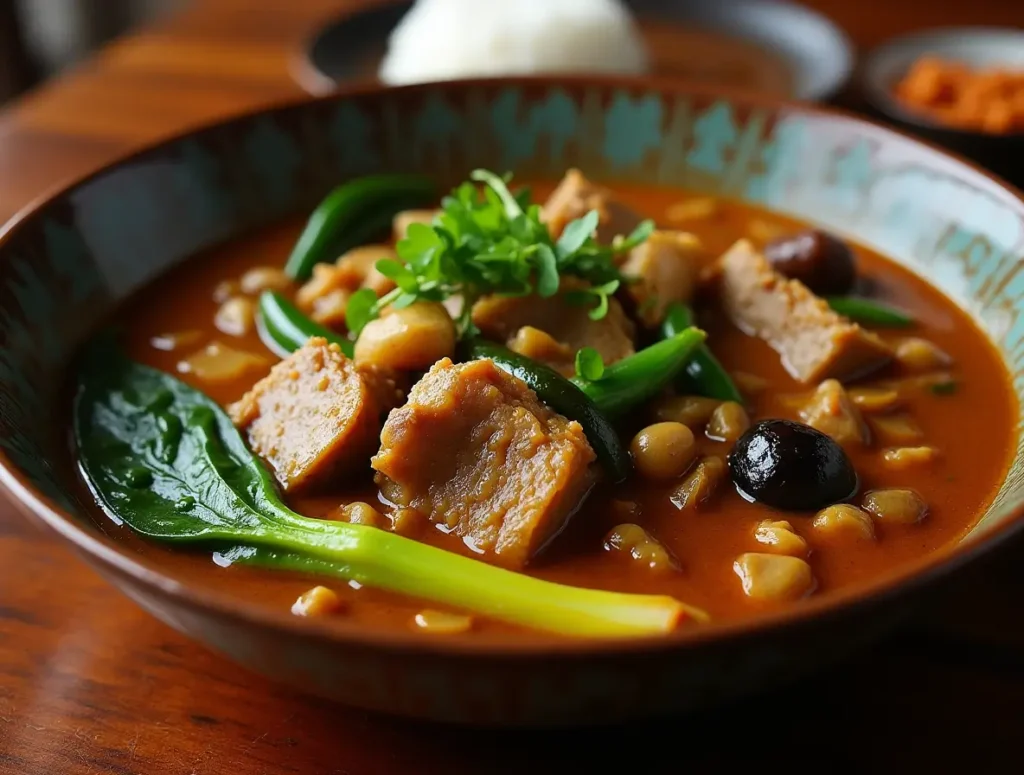
Recipe Schema Markup:
- Preparation Time: PT30M
- Cooking Time: PT2H
- Total Time: PT2H30M
- Type of recipe: Main Course
- Cuisine: Filipino
- Keywords: Kare-Kare, Filipino stew, peanut sauce, oxtail stew, Filipino cuisine, comfort food, weekend dinner, family meal
- Recipe Yield: 6-8 servings
- Calories: 485 calories per serving
Pros:
- Authentic Filipino flavor with easy-to-find ingredients
- Creates tender, fall-off-the-bone meat texture
- Rich, velvety peanut sauce with complex flavor
- Makes excellent leftovers that improve with time
- Impressive dish for special occasions and gatherings
- Can be adapted for different meat preferences
- Perfect balance of meat, vegetables, and sauce
Cons:
- Relatively long cooking time (mostly hands-off)
- Traditional ingredients like banana flowers may be hard to find
- Requires multiple cooking steps and pots
- Bagoong (shrimp paste) may be an acquired taste for some
- Higher calorie content due to peanut butter base
Recipe Instructions:
- Pre-boil oxtail for 10 minutes, drain and rinse
- Simmer cleaned meat in fresh water for 1.5-2 hours until tender
- Make peanut sauce by sautéing onions, garlic, and annatto powder
- Add peanut butter, beef broth, and ground toasted rice to create sauce
- Combine tender meat with peanut sauce, add seasonings
- Add vegetables in stages based on cooking time
- Adjust consistency and seasonings to taste
- Serve hot with rice and bagoong alamang

